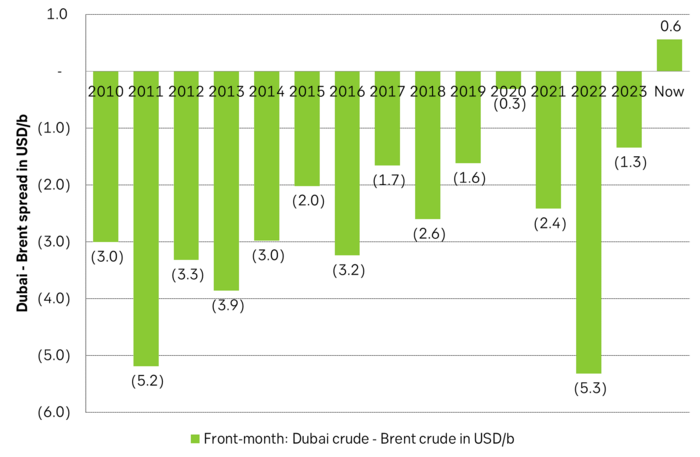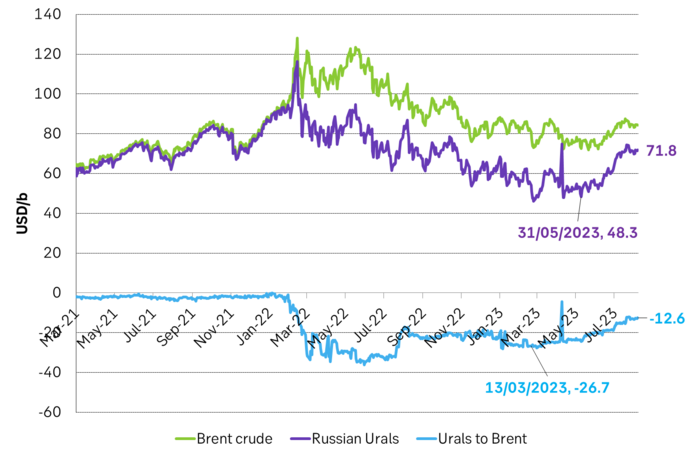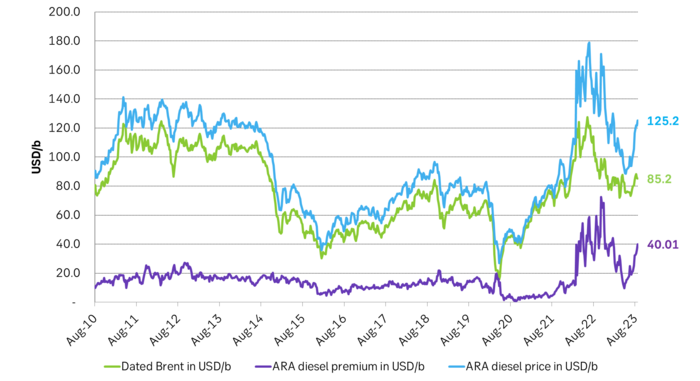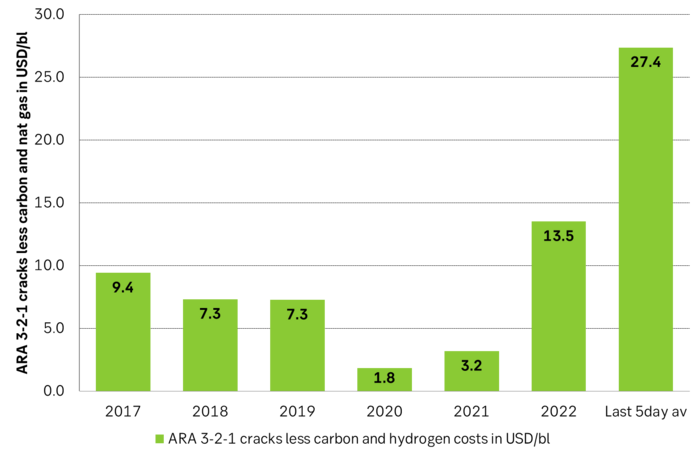Analys
Ultra tight market for medium sour crude and middle distillates

The world is craving for medium sour crude, middle distillates and heavier products. Deep cuts by OPEC+ has created a super tight market for medium to heavy crudes. So tight that Dubai crude now trades at a USD 0.6/b premium to Brent crude rather than a normal discount. All of Russia’s crudes are now trading above the USD 60/b price cap set by the US. Scarcity of such crudes, rich on middle distillates and heavy products, is naturally leading to a scarcity of middle distillates and heavier products. Global inventories of such products are now very low and refining margins are skyrocketing with diesel in Europe now at USD 125/b. There is no sign that Saudi Arabia will shift away from its current ”price over volume” strategy as it is expected to lift its official selling prices for October. Crude oil at USD 85/b is a blissful heaven for Saudi Arabia. As long as US shale oil is shedding drilling rigs at a WTI oil price of USD 80/b there is no reason for Saudi Arabia to fear any shale oil boom which potentially could rob if of market shares. So ”price over volume” is the name of the game.

Production by OPEC+ has declined by 2.7 m b/d from Sep-2022 to Aug-2023. Most of this reduction has taken place since February this year. Global demand on the other hand has increased by 2.4 m b/d from Q3-2022 to Q3-2023. This counter move between supply from OPEC+ vs. global demand has been partially eased by a 1.4 m b/d increase in supply by OECD producers, mostly US shale oil (light sweet crude).
There has thus been a massive tightening in the supply of medium sour crude (medium weight and sulfur > 1%) from OPEC+. Naturally so because this is the type of crude which OPEC+ predominantly is producing. So when the organisation makes deep cuts it leads to a tightening of the medium sour crude market.
The situation has been exacerbated by several factors. The first is Europe which no longer is importing neither crude nor oil products from Russia. The EU28 used to import 4.3 m b/d of crude and products from Russia before the war in Ukraine. Predominantly medium sour crude (Urals), lots of diesel but also lots of heavier components like VGO and different kinds of heavy refinery residues like bunker oil etc. Refineries are huge, complex, specialized machines which are individually tailor made for specific tasks and feed stocks. Without the specific feed stocks they were made for they typically cannot run optimally and have to run at reduced rates thus churning out less finished oil products. Europe has to some degree been able to import medium sour crude from the Middle East and other places to replace the 4.3 m b/d of lost supply from Russia, but it has also been forced to replace it with light sweet crude from the US which is yielding much less diesel or heavier products. The Vacuum Gasoil (VGO) and other heavy feed stocks which the EU used to import from Russia were typically converted to diesel products in deep conversion units. The second factor which has added to the problem is that more than 5 m b/d of global refining capacity has been decommissioned globally since 2020. Global refining capacity actually contracted in 2021 for the first time!
But bottom line here is that the global market for medium sour crude is now super tight. Predominantly as a result of deep cuts by OPEC+. This has amplified the factors above and led to a super tight situation in medium heavy to heavy products (diesel, jet, bunker oil, etc). It is so tight that bunker oil (HSFO 3.5%) in Europe recently traded at a premium to Brent crude rather than a normal discount of USD 10-20/b. This hasn’t happened since the 1990ies! Another sign of the tightness in medium sour crude is that Dubai crude (API = 31, Sulfur = 2%) now is trading at a premium to Brent crude (API = 38, Sulfur = 0.5%) versus a normal discount of more than USD 2/b.
Global middle distillate stocks are very low as we now head into winter. Inventories of middle distillates and jet fuel in the US is almost equally low as they were one year ago.
The tightness in medium sour crude and diesel products has sent refinery margins skyrocketing. The price of diesel in Europe ARA is now standing at USD 125.2/b. That is down from the crazy prices we had one year ago when diesel prices in Europe almost reached USD 180/b. But current diesel price is on par with the price of diesel from 2011 to 2014 when Brent crude averaged USD 110/b. The diesel refining premium in ARA is now USD 40/b and the premium for jet fuel is USD 45/b. Refineries usually make a profit on diesel, jet and gasoline, a loss on bunker oil and a total refining margin for turning crude oil to products of maybe just USD 5/b before operating and capital cost leaving them with limited or even negative margins overall. Now they are making a killing. As a result they will buy as much crude as they can and turn it into the needed products. What they want more than anything is medium sour crudes which have rich contents of middle distillates. But the supply of that crude is now super tight due to deliberate cuts by Saudi Arabia and now also Russia.
There is no sign that Saudi Arabia and Russia will back down any time soon. Saudi Arabia is about to set its official selling prices (OSPs) for October and indications are that they will increase their prices. That implies that Saudi Arabia will continue its ”price over volume” strategy. No signs that they will change on this any time soon. US shale oil producers are still shedding drilling rigs and supply growth there is slowing = Power to OPEC+ to control the market.
Saudi Arabia will also decide over the coming days what they will do with their unilateral production cut for October. Will it roll forward their current production of 9 m b/d or will they add some crude and lift it to for example 9.5 m b/d? Hard to say, but what is clear is that the global market currently is craving for more diesel, heavy products and medium sour crude. Our view is that Saudi Arabia will not risk driving crude oil prices to USD 100 – 110/b or higher through deliberate cuts as this will lead to elevated political storm from the US and maybe also from China. We think that Saudi Arabia is utterly happy with the current oil price of USD 85/b and want to keep it at that level. Getting it exactly right is of course tricky, but they do have the capacity to at least get it ballpark right.
Russia should be super happy. The tight medium sour crude market has sent the price of all their crude exports to above the USD 60/b cap. The price of Urals has increased from USD 50/b in May to now USD 71/b. This is of course a headache for the western who is trying to limit Russian oil revenue.
Deep cuts by OPEC+ over the past year. In total 2.7 m b/d since Sep 2022. But accelerating cuts since February 2023. Deliberate cuts by Saudi Arabia and in part by Russia. It has created a super tight market for medium sour crude as global demand has rallied 2.4 m b/d over the past year.

Price spread Dubai – Brent. Dubai usually trades at a discount to Brent crude. Now it trades at a premium of USD 0.6/b. Highly unusual! A sign of a very tight medium sour crude oil market.

The price discount for Russian Urals crude is evaporating as the market for medium sour crude oil has tightened.

ARA diesel prices have rallied since their low point in April. Diesel in ARA now costs USD 125/b and equally much as it did from 2011 to 2014 when Brent crude traded at USD 110/b.

Refineries are making a killing as refining margins for diesel, jet and gasoline have skyrocketed while the usual loss making component, bunker oil, now almost trades on par with Brent crude. Refineries, the primary buyers of crude, will buy as much crude oil as they can to make yet more money. This should help to keep demand for crude oil elevated and thus prices for crude oil elevated.

Analys
Crude oil soon coming to a port near you

Rebounding along with most markets. But concerns over solidity of Gaza peace may also contribute. Brent crude fell 0.8% yesterday to $61.91/b and its lowest close since May this year. This morning it is bouncing up 0.9% to $62.5/b along with a softer USD amid positive sentiment with both equities and industrial metals moving higher. Concerns that the peace in Gaza may be less solid than what one might hope for also yields some support to Brent. Bets on tech stocks are rebounding, defying fears of trade war. Money moving back into markets. Gold continues upwards its strong trend and a softer dollar helps it higher today as well.

US crude & products probably rose 5.6 mb last week (API) versus a normal seasonal decline of 2.4 mb. The US API last night partial and thus indicative data for US oil inventories. Their data indicates that US crude stocks rose 7.4 mb last week, gasoline stocks rose 3.0 mb while Distillate stocks fell 4.8 mb. Altogether an increase in commercial crude and product stocks of 5.6 mb. Commercial US crude and product stocks normally decline by 2.4 mb this time of year. So seasonally adjusted the US inventories rose 8 mb last week according to the indicative numbers by the API. That is a lot. Also, the counter seasonal trend of rising stocks versus normally declining stocks this time of year looks on a solid pace of continuation. If the API is correct then total US crude and product stocks would stand 41 mb higher than one year ago and 6 mb higher than the 2015-19 average. And if we combine this with our knowledge of a sharp increase in production and exports by OPEC(+) and a large increase in oil at sea, then the current trend in US oil inventories looks set to continue. So higher stocks and lower crude oil prices until OPEC(+) switch to cuts. Actual US oil inventory data today at 18:00 CET.
US commercial crude and product stocks rising to 1293 mb in week 41 if last nights indicative numbers from API are correct.

Crude oil soon coming to a port near you. OPEC has lifted production sharply higher this autumn. At the same time demand for oil in the Middle-East has fallen as we have moved out of summer heat and crude oil burn for power for air-conditioning. The Middle-East oil producers have thus been able to lift exports higher on both accounts. Crude oil and condensates on water has shot up by 177 mb since mid-August. This oil is now on its way to ports around the world. And when they arrive, it will likely help to lift stocks onshore higher. That is probably when we will lose the last bit of front-end backwardation the the crude oil curves. That will help to drive the front-month Brent crude oil price down to the $60/b line and revisit the high $50ies/b. Then the eyes will be all back on OPEC+ when they meet in early November and then again in early December.
Crude oil and condensates at sea have moved straight up by 177 mb since mid-August as OPEC(+) has produced more, consumed less and exported more.

Analys
The Mid-East anchor dragging crude oil lower

When it starts to move lower it moves rather quickly. Gaza, China, IEA. Brent crude is down 2.1% today to $62/b after having traded as high as $66.58/b last Thursday and above $70/b in late September. The sell-off follows the truce/peace in Gaze, a flareup in US-China trade and yet another bearish oil outlook from the IEA.

A lasting peace in Gaze could drive crude oil at sea to onshore stocks. A lasting peace in Gaza would probably calm down the Houthis and thus allow more normal shipments of crude oil to sail through the Suez Canal, the Red Sea and out through the Bab-el-Mandeb Strait. Crude oil at sea has risen from 48 mb in April to now 91 mb versus a pre-Covid normal of about 50-60 mb. The rise to 91 mb is probably the result of crude sailing around Africa to be shot to pieces by the Houthis. If sailings were to normalize through the Suez Canal, then it could free up some 40 mb in transit at sea moving onshore into stocks.
The US-China trade conflict is of course bearish for demand if it continues.
Bearish IEA yet again. Getting closer to 2026. Credibility rises. We expect OPEC to cut end of 2025. The bearish monthly report from the IEA is what it is, but the closer we get to 2026, the more likely the IEA is of being ball-park right in its outlook. In its monthly report today the IEA estimates that the need for crude oil from OPEC in 2026 will be 25.4 mb/d versus production by the group in September of 29.1 mb/d. The group thus needs to do some serious cutting at the end of 2025 if it wants to keep the market balanced and avoid inventories from skyrocketing. Given that IEA is correct that is. We do however expect OPEC to implement cuts to avoid a large increase in inventories in Q1-26. The group will probably revert to cuts either at its early December meeting when they discuss production for January or in early January when they discuss production for February. The oil price will likely head yet lower until the group reverts to cuts.
Dubai: The Mid-East anchor dragging crude oil lower. Surplus emerging in Mid-East pricing. Crude oil prices held surprisingly strong all through the summer. A sign and a key source of that strength came from the strength in the front-end backwardation of the Dubai crude oil curve. It held out strong from mid-June and all until late September with an average 1-3mth time-spread premium of $1.8/b from mid-June to end of September. The 1-3mth time-spreads for Brent and WTI however were in steady deterioration from late June while their flat prices probably were held up by the strength coming from the Persian Gulf. Then in late September the strength in the Dubai curve suddenly collapsed. Since the start of October it has been weaker than both the Brent and the WTI curves. The Dubai 1-3mth time-spread now only stands at $0.25/b. The Middle East is now exporting more as it is producing more and also consuming less following elevated summer crude burn for power (Aircon) etc.
The only bear-element missing is a sudden and solid rise in OECD stocks. The only thing that is missing for the bear-case everyone have been waiting for is a solid, visible rise in OECD stocks in general and US oil stocks specifically. So watch out for US API indications tomorrow and official US oil inventories on Thursday.
No sign of any kind of fire-sale of oil from Saudi Arabia yet. To what we can see, Saudi Arabia is not at all struggling to sell its oil. It only lowered its Official Selling Prices (OSPs) to Asia marginally for November. A surplus market + Saudi determination to sell its oil to the market would normally lead to a sharp lowering of Saudi OSPs to Asia. Not yet at least and not for November.
The 5yr contract close to fixed at $68/b. Of importance with respect to how far down oil can/will go. When the oil market moves into a surplus then the spot price starts to trade in a large discount to the 5yr contract. Typically $10-15/b below the 5yr contract on average in bear-years (2009, 2015, 2016, 2020). But the 5yr contract is usually pulled lower as well thus making this approach a moving target. But the 5yr contract price has now been rock solidly been pegged to $68/b since 2022. And in the 2022 bull-year (Brent spot average $99/b), the 5yr contract only went to $72/b on average. If we assume that the same goes for the downside and that 2026 is a bear-year then the 5yr goes to $64/b while the spot is trading at a $10-15/b discount to that. That would imply an average spot price next year of $49-54/b. But that is if OPEC doesn’t revert to cuts and instead keeps production flowing. We think OPEC(+) will trim/cut production as needed into 2026 to prevent a huge build-up in global oil stocks and a crash in prices. But for now we are still heading lower. Into the $50ies/b.
Analys
More weakness and lower price levels ahead, but the world won’t drown in oil in 2026

Some rebound but not much. Brent crude rebounded 1.5% yesterday to $65.47/b. This morning it is inching 0.2% up to $65.6/b. The lowest close last week was on Thursday at $64.11/b.

The curve structure is almost as week as it was before the weekend. The rebound we now have gotten post the message from OPEC+ over the weekend is to a large degree a rebound along the curve rather than much strengthening at the front-end of the curve. That part of the curve structure is almost as weak as it was last Thursday.
We are still on a weakening path. The message from OPEC+ over the weekend was we are still on a weakening path with rising supply from the group. It is just not as rapidly weakening as was feared ahead of the weekend when a quota hike of 500 kb/d/mth for November was discussed.
The Brent curve is on its way to full contango with Brent dipping into the $50ies/b. Thus the ongoing weakening we have had in the crude curve since the start of the year, and especially since early June, will continue until the Brent crude oil forward curve is in full contango along with visibly rising US and OECD oil inventories. The front-month Brent contract will then flip down towards the $60/b-line and below into the $50ies/b.
At what point will OPEC+ turn to cuts? The big question then becomes: When will OPEC+ turn around to make some cuts? At what (price) point will they choose to stabilize the market? Because for sure they will. Higher oil inventories, some more shedding of drilling rigs in US shale and Brent into the 50ies somewhere is probably where the group will step in.
There is nothing we have seen from the group so far which indicates that they will close their eyes, let the world drown in oil and the oil price crash to $40/b or below.
The message from OPEC+ is also about balance and stability. The world won’t drown in oil in 2026. The message from the group as far as we manage to interpret it is twofold: 1) Taking back market share which requires a lower price for non-OPEC+ to back off a bit, and 2) Oil market stability and balance. It is not just about 1. Thus fretting about how we are all going to drown in oil in 2026 is totally off the mark by just focusing on point 1.
When to buy cal 2026? Before Christmas when Brent hits $55/b and before OPEC+ holds its last meeting of the year which is likely to be in early December.
Brent crude oil prices have rebounded a bit along the forward curve. Not much strengthening in the structure of the curve. The front-end backwardation is not much stronger today than on its weakest level so far this year which was on Thursday last week.

The front-end backwardation fell to its weakest level so far this year on Thursday last week. A slight pickup yesterday and today, but still very close to the weakest year to date. More oil from OPEC+ in the coming months and softer demand and rising inventories. We are heading for yet softer levels.

-

 Nyheter3 veckor sedan
Nyheter3 veckor sedanOPEC+ missar produktionsmål, stöder oljepriserna
-

 Nyheter3 veckor sedan
Nyheter3 veckor sedanEtt samtal om guld, olja, fjärrvärme och förnybar energi
-

 Nyheter2 veckor sedan
Nyheter2 veckor sedanGuld nära 4000 USD och silver 50 USD, därför kan de fortsätta stiga
-

 Nyheter1 vecka sedan
Nyheter1 vecka sedanGoldman Sachs höjer prognosen för guld, tror priset når 4900 USD
-

 Analys3 veckor sedan
Analys3 veckor sedanAre Ukraine’s attacks on Russian energy infrastructure working?
-

 Nyheter2 veckor sedan
Nyheter2 veckor sedanBlykalla och amerikanska Oklo inleder ett samarbete
-

 Nyheter4 veckor sedan
Nyheter4 veckor sedanGuldpriset uppe på nya höjder, nu 3750 USD
-

 Nyheter2 veckor sedan
Nyheter2 veckor sedanEtt samtal om guld, olja, koppar och stål







